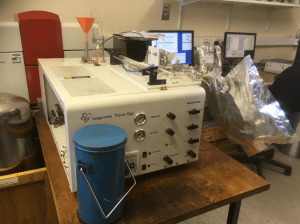Wednesday 30th January
While FAAM and the ZWAMPS team head on to Zambia, I have returned home from a busy week of air sampling in Uganda. This week I’m back in the greenhouse gas lab at Royal Holloway. Soon we will have a lab full of Ugandan and Zambian air in Flexfoil bags and WAS cases, so we need to make some space.
Once the air samples return to Royal Holloway we will first measure methane and carbon dioxide mole fraction in each sample using a Picarro cavity ringdown spectrometer, and we will check the measurements against those made by the onboard FGGA. Then it’s over to the mass spectrometer for methane isotopic analysis. We use continuous flow isotope ratio mass spectrometry to measure δ13C in methane in permil (‰). Each sample takes around an hour to analyse, and with more than 500 air samples expected from the MOYA and ZWAMPS campaigns that will mean a lot of time spent in the lab over the coming weeks.
Methane in background ambient air has an isotopic composition of around -47 ‰. Methane from biogenic sources such as wetlands is more depleted in 13C, making the isotopic composition more negative. Methane from fires is relatively enriched in 13C, making the isotopic composition less negative. This paper by Rebecca Brownlow provides some of the isotopic signatures we have measured from tropical methane sources in previous ground campaigns: https://agupubs.onlinelibrary.wiley.com/doi/full/10.1002/2017GB005689
Isotopic analysis of the samples collected onboard the aircraft will help distinguish the proportion of methane from fires and from wetlands in methane elevations seen over wide areas of tropical Africa.
By Rebecca Fisher
